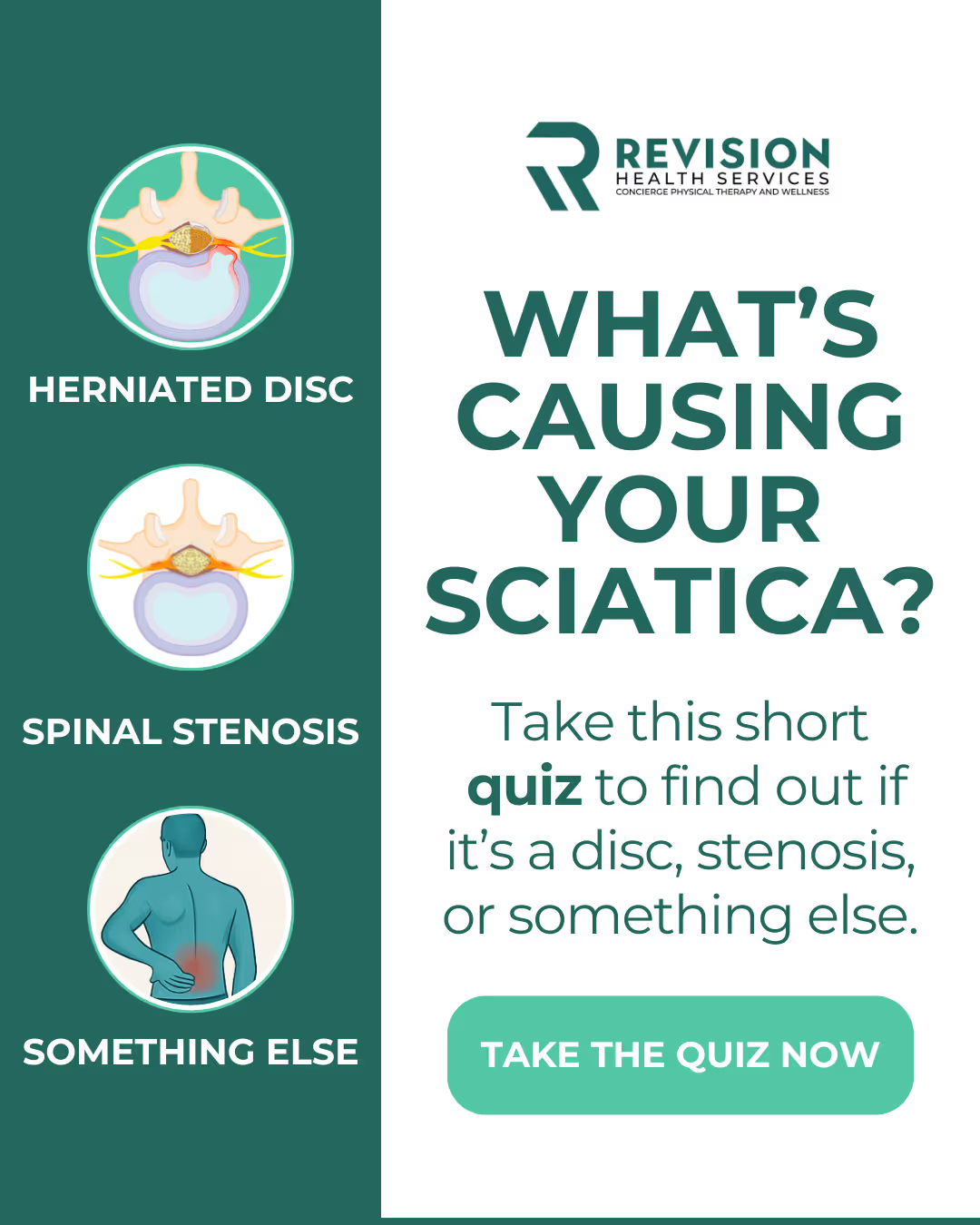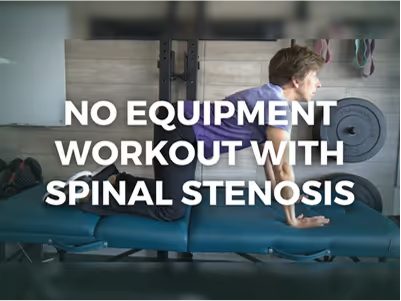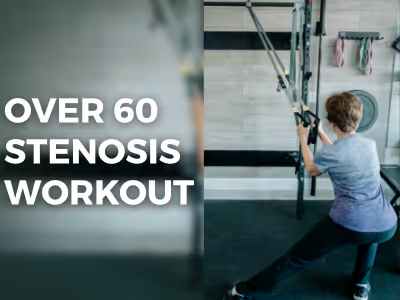.jpg)
Safe Weight Lifting Exercises with Sciatica (And Which to Avoid)
Many of my patients and clients are curious about how to lift weights safely with sciatica or how to resume exercising without exacerbating their condition.
Honestly, the most accurate answer is whatever feels best for your body, as long as your sciatic nerve stays safe. However, I'd like to share with you what I offer some of my clients.
The framework I use is SPARK. I discuss this more in my book, but essentially, we protect nerves during exercise to avoid worsening the issue. We do this by:
- Strengthening around the nerve
- Pain Relief
- Activating the nerve
- Regaining mobility
- Keep moving
When we discuss weightlifting or strengthening, we are also referring to the routine you use to perform the weightlifting. You can easily find the perfect stretches, pain-relieving strategies, nerve mobility exercises, and spinal mobility exercises in my book, Revision Sciatica.
We also created a free quiz that helps you determine whether you are dealing with a disc herniation or spinal stenosis.
3 Weight Lifting Exercises That Are Safe With Sciatica
Safe exercises include:
- Romanian Dead Lifts
- Bench Press
- Squat Before Butt Tuck
What you want to avoid:
- Deep squats
- Heavy weights
Romanian Deadlifts: Strengthen the Spine and Glide the Sciatica Nerve
This exercise allows you to glide, stretch, and strengthen the entire posterior chain. These are essential for improving back pain and sciatica. Start with feet about hip width. Then, as you slide the weight down your legs, keep your back very straight and knees slightly bent. The movement comes from your hips. You will stick your butt out and bend over from the waist until you feel a pull in the back of your legs. More range isn't better! You may also feel your sciatica symptoms here. Stop at that point.
Start with no weight and slowly progress each week, as long as your back and sciatica hold up.
- 2 sets of 12 repetitions


Bench Press and Other Upper Body Exercises
Bench press and other upper-body exercises are typically ok as long as you can set them up without experiencing pain. I like to start with push-ups for about a week, then progress to dumbbell bench, and finally the regular bench press.
Tip: If you do a barbell bench, try to keep your feet on the bench and your back supported. That can help!

Squats Before Butt Wink: Back and Hip Strength
Squats can be challenging at first, so it’s best to avoid heavy weights or heavy back squats until you're ready. You can progress with them, but it will take time. Start with a gradual progression, as shown below. However you progress, I recommend avoiding the deep ranges of motion or the butt wink. The very end of the squat's range of motion is when your lower back tilts underneath you. It's hard to tell on your own, so I recommend not going back 90 degrees. That will be a good way to remember.
While spinal compression during squats can be beneficial for disc health, it's essential to proceed slowly and wait a week or so before progressing to the next variation.
- Begin by testing bodyweight squats—if you can do them pain-free
- Try a weighted lunge with dumbbells
- Then, goblet squats
- And, eventually, barbell squats

If you are looking for more workouts for Sciatica, here is a resource for $7 on Workout for Sciatica and Lower Back Pain.
Exercises to Avoid With Sciatica
Deep Squats
While squatting can be perfectly safe if you have a history of sciatica, progressing the depth of the squat may be more challenging. As mentioned above, squatting below 90 degrees, or into ranges that require greater lumbar spine flexion (forward bend), can increase your pain if you are in the acute or subacute phase of healing. That said, it depends entirely on your specific circumstances. You may be able to handle a deeper squat if you have proper form and sufficient mobility. Just remember to progress slowly and carefully and consult a PT that you trust to make appropriate modifications.
Heavy Weights
What even is a heavyweight? This is context-dependent, but in my experience, people are much stronger than they give themselves credit for. Especially women (sorry, guys). Oftentimes, my clients are hesitant to lift more than a 10 or 15-pound dumbbell because they think they will flare up their sciatica. But they won’t think twice about lifting their child or a bag weighing 30+ lbs. Regardless of the exercise, once you establish proper form and are familiar with your pain-free range, it is recommended to progress to heavier weights to build strength! That’s what it’s all about. The key is to do it with careful intention, so you stimulate change without exceeding your capacity for recovery.
Can You Still Lift Weights with Sciatica?
Yes, you can absolutely keep lifting weights, the key is how you do it. I tell my patients that a little soreness right after lifting can be normal, but if your pain kicks in about eight hours later, that’s a sign something needs to change. The most common trigger for sciatica pain is forward flexion, or bending forward. If that movement makes your symptoms worse, skip or modify exercises that involve it, like certain deadlifts or knee-to-chest motions that flex the spine. Remember, it’s usually not what you do but how you do it. That’s the focus of my YouTube channel and workout programs, helping you move safely so you can get back to lifting confidently. Often, starting with upper-body exercises before reintroducing lower-body and core work is the best approach. It's also important to determine what is causing your sciatica. That's why I created a free quiz to get you started.

Which Gym Equipment Should I Avoid with Sciatica?
This is where gym equipment or machines can shine. They are often a great way to strengthen without making things worse. The two machines that I avoid are the squat machine and the Ab roller.
The squat or leg press machine is often in a tight space and will immediately require you to flex your lumbar spine to its full range of motion. I would rather you do seated leg extensions or some of the exercises we discussed above.
The ab roller seems harmless, but this bad boy rapidly increases abdominal pressure, which may feel like a good ab workout, but it also puts pressure on the disc and nerve very quickly. Instead, do a standard plank and focus on small, gentle breaths.
Can you Build Muscle with Sciatica?
You can absolutely build muscle while managing sciatica. As mentioned earlier, many exercises won’t aggravate your leg pain. If your pain is severe, focusing on upper-body workouts can help you stay active while you heal. Most leg machines and core exercises that target the lower back are also safe to use. Sciatica may slow you down, but it doesn’t have to keep you sidelined for long!
The basic muscle-building principles I have my patients follow are:
- Protein before and after the workout, within 30 min for men and 15 min for women.
- 15 grams or so each time
- Focus on 12-15 reps and 2-3 sets
- 2-3 times per week
- 8-10 total exercises
Summary
If you’re dealing with sciatica, you can still lift weights safely, it’s all about protecting the nerve and moving with intention. Using the SPARK framework (Strengthen, Pain relief, Activate, Regain mobility, Keep moving), you can build strength while minimizing flare-ups. Focus on safe exercises like Romanian deadlifts, bench presses, and controlled squats, and avoid deep squats or heavy weights until your body is ready.
Many of my patients and clients are curious about how to lift weights safely with sciatica or how to resume exercising without exacerbating their condition.
Honestly, the most accurate answer is whatever feels best for your body, as long as your sciatic nerve stays safe. However, I'd like to share with you what I offer some of my clients.
The framework I use is SPARK. I discuss this more in my book, but essentially, we protect nerves during exercise to avoid worsening the issue. We do this by:
- Strengthening around the nerve
- Pain Relief
- Activating the nerve
- Regaining mobility
- Keep moving
When we discuss weightlifting or strengthening, we are also referring to the routine you use to perform the weightlifting. You can easily find the perfect stretches, pain-relieving strategies, nerve mobility exercises, and spinal mobility exercises in my book, Revision Sciatica.
We also created a free quiz that helps you determine whether you are dealing with a disc herniation or spinal stenosis.
3 Weight Lifting Exercises That Are Safe With Sciatica
Safe exercises include:
- Romanian Dead Lifts
- Bench Press
- Squat Before Butt Tuck
What you want to avoid:
- Deep squats
- Heavy weights
Romanian Deadlifts: Strengthen the Spine and Glide the Sciatica Nerve
This exercise allows you to glide, stretch, and strengthen the entire posterior chain. These are essential for improving back pain and sciatica. Start with feet about hip width. Then, as you slide the weight down your legs, keep your back very straight and knees slightly bent. The movement comes from your hips. You will stick your butt out and bend over from the waist until you feel a pull in the back of your legs. More range isn't better! You may also feel your sciatica symptoms here. Stop at that point.
Start with no weight and slowly progress each week, as long as your back and sciatica hold up.
- 2 sets of 12 repetitions


Bench Press and Other Upper Body Exercises
Bench press and other upper-body exercises are typically ok as long as you can set them up without experiencing pain. I like to start with push-ups for about a week, then progress to dumbbell bench, and finally the regular bench press.
Tip: If you do a barbell bench, try to keep your feet on the bench and your back supported. That can help!

Squats Before Butt Wink: Back and Hip Strength
Squats can be challenging at first, so it’s best to avoid heavy weights or heavy back squats until you're ready. You can progress with them, but it will take time. Start with a gradual progression, as shown below. However you progress, I recommend avoiding the deep ranges of motion or the butt wink. The very end of the squat's range of motion is when your lower back tilts underneath you. It's hard to tell on your own, so I recommend not going back 90 degrees. That will be a good way to remember.
While spinal compression during squats can be beneficial for disc health, it's essential to proceed slowly and wait a week or so before progressing to the next variation.
- Begin by testing bodyweight squats—if you can do them pain-free
- Try a weighted lunge with dumbbells
- Then, goblet squats
- And, eventually, barbell squats

If you are looking for more workouts for Sciatica, here is a resource for $7 on Workout for Sciatica and Lower Back Pain.
Exercises to Avoid With Sciatica
Deep Squats
While squatting can be perfectly safe if you have a history of sciatica, progressing the depth of the squat may be more challenging. As mentioned above, squatting below 90 degrees, or into ranges that require greater lumbar spine flexion (forward bend), can increase your pain if you are in the acute or subacute phase of healing. That said, it depends entirely on your specific circumstances. You may be able to handle a deeper squat if you have proper form and sufficient mobility. Just remember to progress slowly and carefully and consult a PT that you trust to make appropriate modifications.
Heavy Weights
What even is a heavyweight? This is context-dependent, but in my experience, people are much stronger than they give themselves credit for. Especially women (sorry, guys). Oftentimes, my clients are hesitant to lift more than a 10 or 15-pound dumbbell because they think they will flare up their sciatica. But they won’t think twice about lifting their child or a bag weighing 30+ lbs. Regardless of the exercise, once you establish proper form and are familiar with your pain-free range, it is recommended to progress to heavier weights to build strength! That’s what it’s all about. The key is to do it with careful intention, so you stimulate change without exceeding your capacity for recovery.
Can You Still Lift Weights with Sciatica?
Yes, you can absolutely keep lifting weights, the key is how you do it. I tell my patients that a little soreness right after lifting can be normal, but if your pain kicks in about eight hours later, that’s a sign something needs to change. The most common trigger for sciatica pain is forward flexion, or bending forward. If that movement makes your symptoms worse, skip or modify exercises that involve it, like certain deadlifts or knee-to-chest motions that flex the spine. Remember, it’s usually not what you do but how you do it. That’s the focus of my YouTube channel and workout programs, helping you move safely so you can get back to lifting confidently. Often, starting with upper-body exercises before reintroducing lower-body and core work is the best approach. It's also important to determine what is causing your sciatica. That's why I created a free quiz to get you started.

Which Gym Equipment Should I Avoid with Sciatica?
This is where gym equipment or machines can shine. They are often a great way to strengthen without making things worse. The two machines that I avoid are the squat machine and the Ab roller.
The squat or leg press machine is often in a tight space and will immediately require you to flex your lumbar spine to its full range of motion. I would rather you do seated leg extensions or some of the exercises we discussed above.
The ab roller seems harmless, but this bad boy rapidly increases abdominal pressure, which may feel like a good ab workout, but it also puts pressure on the disc and nerve very quickly. Instead, do a standard plank and focus on small, gentle breaths.
Can you Build Muscle with Sciatica?
You can absolutely build muscle while managing sciatica. As mentioned earlier, many exercises won’t aggravate your leg pain. If your pain is severe, focusing on upper-body workouts can help you stay active while you heal. Most leg machines and core exercises that target the lower back are also safe to use. Sciatica may slow you down, but it doesn’t have to keep you sidelined for long!
The basic muscle-building principles I have my patients follow are:
- Protein before and after the workout, within 30 min for men and 15 min for women.
- 15 grams or so each time
- Focus on 12-15 reps and 2-3 sets
- 2-3 times per week
- 8-10 total exercises
Summary
If you’re dealing with sciatica, you can still lift weights safely, it’s all about protecting the nerve and moving with intention. Using the SPARK framework (Strengthen, Pain relief, Activate, Regain mobility, Keep moving), you can build strength while minimizing flare-ups. Focus on safe exercises like Romanian deadlifts, bench presses, and controlled squats, and avoid deep squats or heavy weights until your body is ready.
.jpg)



%20Blog%20thumbnails%204.avif)

%20Older%20Adult%20Workout%20for%20Sciatica%20Without%20Getting%20on%20the%20floor.avif)

%20FREE%2024%20Core%20Strengthening%20Exercises%20PDF%20Guide.avif)

%20Ultimate%20Sciatica%20Stretch%20Workout.avif)

%20Core%20workout%20for%20Sciatica.avif)
%20Pain%20Free%20Walking%20Calendar.png)
%20The%20Ultimate%20Guide%20for%20Stretching%20Your%20Lower%20Back!.avif)
%20V1.avif)


%20FREE%20Sciatica%20Pain%20Relief%20PDF.avif)
%20%20I%20Have%20Some%20Extra%20Cushion%20Workout%20With%20Sciatica.avif)

%20B%26A%20Back%20Surgery.avif)
%20Sciatica%20and%20Lower%20back%20Pain%20Workout.avif)
%20Core%20Calendar.avif)
